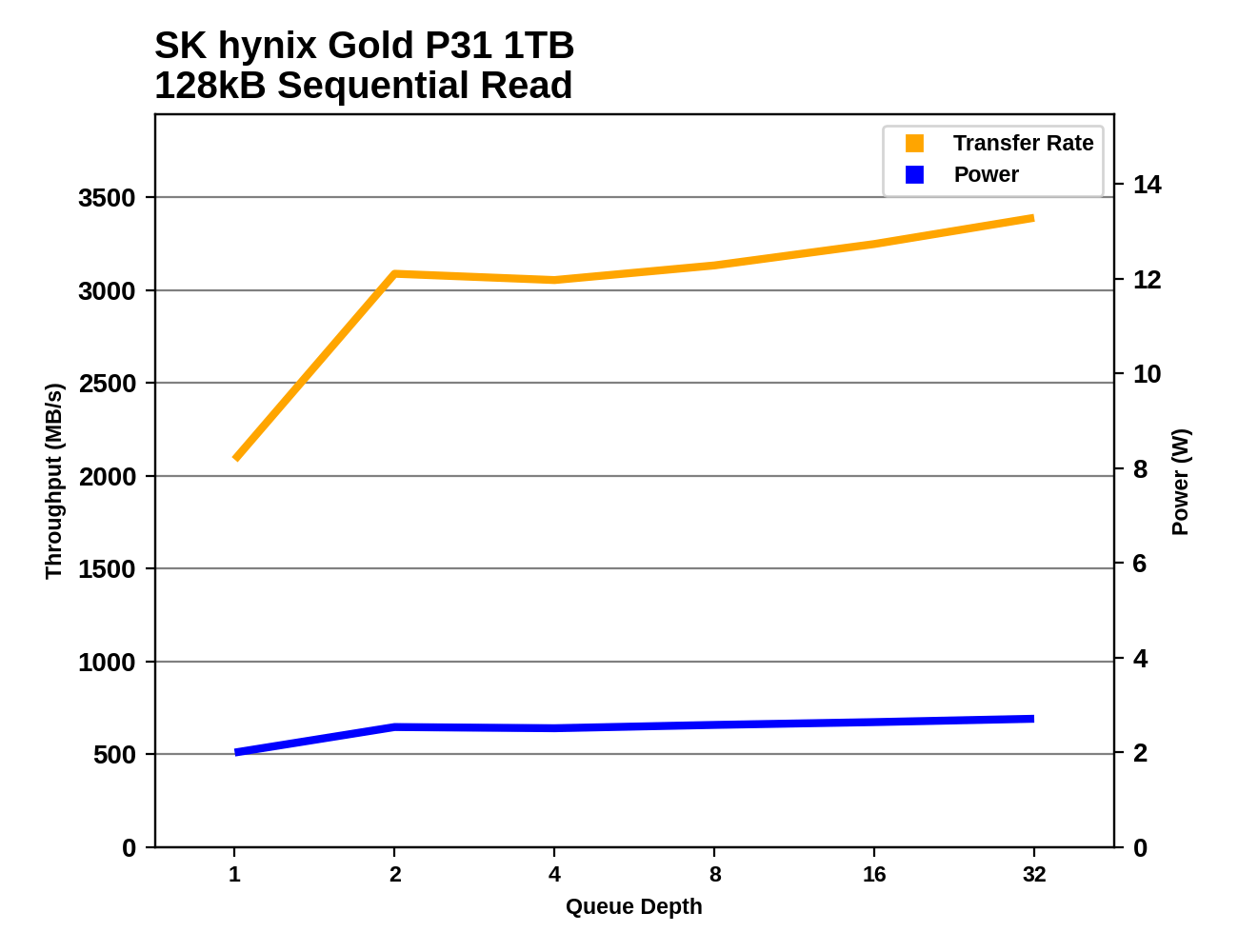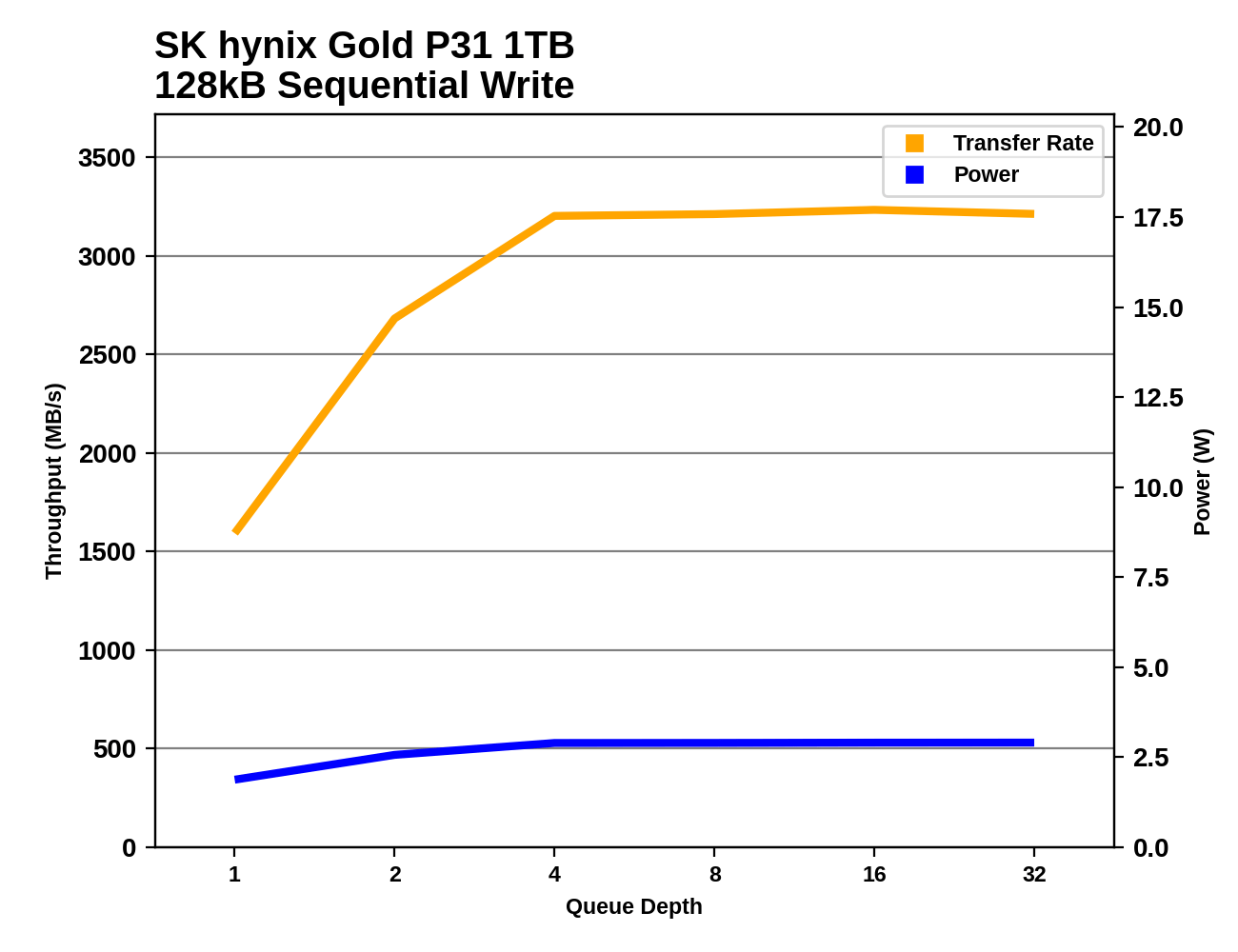The Best NVMe SSD for Laptops and Notebooks: SK hynix Gold P31 1TB SSD Reviewed
by Billy Tallis on August 27, 2020 8:00 AM ESTSequential Read Performance
Our first test of sequential read performance uses short bursts of 128MB, issued as 128kB operations with no queuing. The test averages performance across eight bursts for a total of 1GB of data transferred from a drive containing 16GB of data. Between each burst the drive is given enough idle time to keep the overall duty cycle at 20%.

The burst sequential read performance from the SK hynix Gold P31 is very good, but not quite fast enough to beat the drives based on the Silicon Motion SM2262EN controller.
Our test of sustained sequential reads uses queue depths from 1 to 32, with the performance and power scores computed as the average of QD1, QD2 and QD4. Each queue depth is tested for up to one minute or 32GB transferred, from a drive containing 64GB of data. This test is run twice: once with the drive prepared by sequentially writing the test data, and again after the random write test has mixed things up, causing fragmentation inside the SSD that isn't visible to the OS. These two scores represent the two extremes of how the drive would perform under real-world usage, where wear leveling and modifications to some existing data will create some internal fragmentation that degrades performance, but usually not to the extent shown here.

On the longer sequential read test that involves some slightly higher queue depths, the Gold P31 is basically tied for first place when reading data that was written sequentially. When reading data that has previously been fragmented by the random write test, the P31's performance is considerably higher than the other flash-based SSDs and closer to the Optane 905P.
 |
|||||||||
| Power Efficiency in MB/s/W | Average Power in W | ||||||||
In absolute terms, the power consumption of the Gold P31 isn't drastically lower than some of the other fairly efficient high-end NVMe drives like the WD Black SN750. But once performance is taken into account, the Gold P31's efficiency stands far above the competition.
 |
|||||||||
The SK hynix Gold P31 doesn't need high queue depths to deliver good sequential read throughput: at QD2 it's already above 3 GB/s, but there are further slight performance increases from higher queue depths. That performance profile is very similar to the Samsung 970 EVO Plus, but that drive requires about twice the power that the P31 uses.
Even at QD1, the sequential read performance from the Gold P31 is above the ~2GB/s limit of most other four-channel NVMe drives we've tested (with eg. Silicon Motion SM2263 based controllers). That leaves it entirely in a performance range where all the competitors are 8-channel drives that don't come close to matching power efficiency of the Gold P31.
Sequential Write Performance
Our test of sequential write burst performance is structured identically to the sequential read burst performance test save for the direction of the data transfer. Each burst writes 128MB as 128kB operations issued at QD1, for a total of 1GB of data written to a drive containing 16GB of data.

The SK hynix Gold P31 has fairly ordinary burst sequential write performance by high-end NVMe standards: tied with the SM2262EN-based ATATA SX8200 Pro but beat by the Phison-based Seagate drives.
Our test of sustained sequential writes is structured identically to our sustained sequential read test, save for the direction of the data transfers. Queue depths range from 1 to 32 and each queue depth is tested for up to one minute or 32GB, followed by up to one minute of idle time for the drive to cool off and perform garbage collection. The test is confined to a 64GB span of the drive.

On the longer sequential write test that brings in higher queue depths, the Gold P31 is tied for second place, while the Phison E16 based Seagate drive (built for PCIe 4 speeds, but limited by this testbed to PCIe 3 speeds) unsurprisingly takes first place.
 |
|||||||||
| Power Efficiency in MB/s/W | Average Power in W | ||||||||
At this point, the record-shattering power efficiency scores from the SK hynix Gold P31 are no longer a surprise. The overall fastest drive has the second best efficiency score (56% the performance per Watt of the P31) and the next two most efficient drives are much slower NVMe drives from Toshiba/Kioxia.
 |
|||||||||
The Gold P31 doesn't reach its full sequential write speed until QD4, while several of its competitors saturate at QD2. However, once the P31 is at full speed, it has one of the best sustained write speeds, and shows no sign of its SLC cache running out at any point during the test. Power consumption is comparable to the slowest NVMe drive that can barely hit half the throughput of the Gold P31.
Similar to the sequential read results, the P31 starts out at QD1 with high performance that almost puts it beyond what other 4-channel NVMe drives can do at any queue depth. From there, the P31 continues to redefine what's possible with an increasingly wide lead in power consumption relative to all other high-end drives we've tested.












80 Comments
View All Comments
vladx - Thursday, August 27, 2020 - link
I have a SX8200 Pro on my laptop, do I need to enable the laptop Power Management state or is it detected automatically by the firmware?Billy Tallis - Thursday, August 27, 2020 - link
That really depends on what combination of firmware and driver bugs the laptop vendor gave you. But in theory, if the machine originally came with a M.2 NVMe drive, it should have been configured for proper power management and should continue to work well with an aftermarket SSD that doesn't bring any new power management bugs. I think the SX8200 Pro is okay on that score; the slow wake-up times shouldn't prevent the system from trying to use the deep idle states because the drive still promises the OS that it will have reasonable wake-up times.vladx - Thursday, August 27, 2020 - link
My laptop is a MSI Creator 17 that came with a Samsung PM981 drive. Could HWinfo offer any help in identifying the active power states?Billy Tallis - Thursday, August 27, 2020 - link
I'm not sure. I think you can figure out what PCIe power management settings are being used by digging through the PCI configuration space, but I'm not sure how easy it is to get that info while running Windows. As for the NVMe power management settings, my understanding is that it's impossible or very nearly impossible to access that information under Windows, at least with the usual NVMe drivers. The only reliable way I know of to confirm that everything is working correctly to get your SSD idling below 10mW is to have expensive power measurement equipment.vladx - Thursday, August 27, 2020 - link
Ok thanks, Billy. I was going to install Fedora anyways as secondary OS so I guess I'll try the Linux route then.MrCommunistGen - Thursday, August 27, 2020 - link
vladx, I'm really interested in how you go about trying to tease the NVMe power management info out of the drive. I did some internet searches a while back and didn't find anything definitive that I was able to follow and get results from. I've only ever used Debian-based distros, but if you're able to figure it out in Fedora then at least I'll know it is possible.Foeketijn - Thursday, August 27, 2020 - link
Did it happen? Did Samsung finally get an actual competitor? It doesn't really beat the 970 evo that much, so the 970 pro would still be better, but not at this price point, and definitely not with this power usage.Last time intel did that, Samsung suddenly woke up and beat them down again to a place where they stayed since.
Interesting to see what the new evo and pro line will bring.
Not high margin prices this time arround I guess.
LarsBolender - Thursday, August 27, 2020 - link
This has to be one of the most positive AnandTech articles I have read in years. Good job SK Hynix!Luminar - Thursday, August 27, 2020 - link
No recommendation sticker, though.Zan Lynx - Thursday, August 27, 2020 - link
It would be handy if you could add a power loss consistency test. I have a Dell with an older hynix NVMe and one time the battery ran down in the bag, and on reboot its btrfs was corrupt.Imagine these are sequence numbers in metadata blocks.
Correct: 10 12 22 30
Actual: 10 12 11 30
The hynix had committed writes for SOME of the blocks but a few in the middle of the update chain were old versions of the data. According to btrfs flush rules that is un-possible. Which means that the drive reported a successful write for 22 and for 30 but after powerloss recovery it lost that write for 22 and reverted to an older block.
I mean, that's better than some of the older flash drives that would trash the entire FTL and lose all the data. But it is not exactly GOOD.
I'm pretty sure Samsung consumer drives will also lose the data but at least they will revert all of the writes following the lost data, so in my example it would revert write 30 also. That would at least leave things in a logically consistent state.